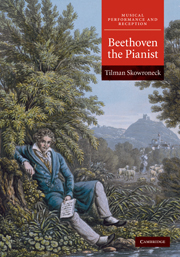Book contents
- Frontmatter
- Contents
- Acknowledgments
- Abbreviations and conventions
- Introduction
- PART I BEETHOVEN, HIS PLAYING, AND HIS INSTRUMENTS
- PART II SOUND IDEAL AND PERFORMANCE
- Introduction
- 5 The builder's influence
- 6 The player's influence
- PART III SOUND IDEAL, NOTATION, AND STYLISTIC CHANGE
- Epilog
- Bibliography
- Index
5 - The builder's influence
from PART II - SOUND IDEAL AND PERFORMANCE
Published online by Cambridge University Press: 06 July 2010
- Frontmatter
- Contents
- Acknowledgments
- Abbreviations and conventions
- Introduction
- PART I BEETHOVEN, HIS PLAYING, AND HIS INSTRUMENTS
- PART II SOUND IDEAL AND PERFORMANCE
- Introduction
- 5 The builder's influence
- 6 The player's influence
- PART III SOUND IDEAL, NOTATION, AND STYLISTIC CHANGE
- Epilog
- Bibliography
- Index
Summary
FORTEPIANOS GOOD AND BAD
Organologists have invested much energy in studies of the various piano action types of the late eighteenth and early nineteenth centuries. From a player's point of view, this research obviously needs no justification: the touch of a keyboard defines the player's contact with the instrument and directly triggers his psychological and artistic response. But the focus on action design distracts from the fact that it has significantly less influence on the tone than all the combined elements of an instrument's construction and the instrument's state of repair.
In 1985, the fortepianist Linda Nicholson wrote about an “alarming variation in quality between different [fortepianos] both old and new,” adding,
There exist even now only a handful of early pianos that may be considered fully satisfactory. Indeed some of those made available in museums and academies and at international festivals and competitions are distressing to the serious player and might be expected to prejudice even the most open-minded listener against the revival of the instrument.
In spite of such inconsistency in fortepiano quality, one occasionally meets a curious lack of concern for an instrument's condition in the literature on early piano performance practices. For example, Sandra Rosenblum includes descriptions of fifteen new and old pianos played for her study, but mentions only in passing that their various tonal properties could be a consequence not only of differences in style but also of their age or state of repair.
- Type
- Chapter
- Information
- Beethoven the Pianist , pp. 124 - 141Publisher: Cambridge University PressPrint publication year: 2010



